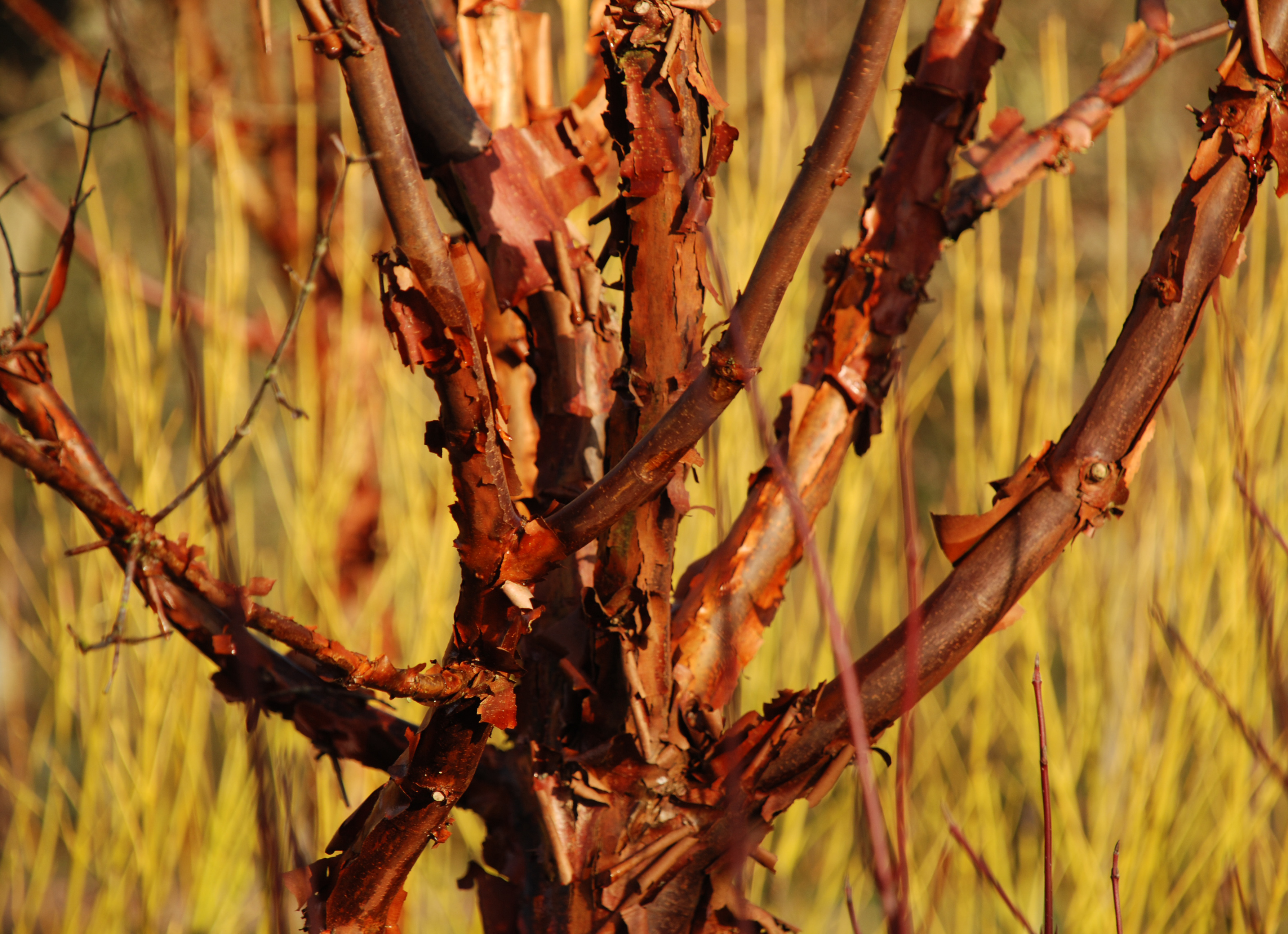Winter is often a forgotten season in the garden but it doesn’t have to be, there are plenty of opportunities to carry a garden through the colder months in style. A well-designed winter garden can be full of elegant, architectural foliage, vibrant stems and dramatic colours. Five designers from the Society of Garden Designers share their tips.
INCORPORATE COLOURFUL STEMS
Plants with colourful stems and bark really come into their own in winter especially planted en masse for maximum impact. 'If you have the space there’s nothing more heartwarming on a dull winters day than a border of dogwoods' says Debbie Roberts MSGD – their colourful winter stems ranging from yellow and gold through to bright orange, red and purple. Punctuated with the white stems of birch trees and evergreen mounds of rhododendron they can create a spectacular winter display.
'Plant them in a spot where they’ll catch the sun they can play an even bigger role' says Lisa Cox MSGD. Her favourites include Acer griseum, rich coppery bark that lights up when the sun catches it.

USE ORNAMENTAL GRASSES
Grasses are a firm favourite in autumn gardens but many of them will retain their billowing shape right through the winter to early spring. 'Resist the temptation to cut down the spent foliage' says Debbie Roberts who favours the low billowy form of Hackonechloa macra for its russet winter tones that provide a soft orange fringe when lit by the winter sun.
'On sparkling cold days in the depths of winter the best and longest lasting grasses can transform gardens into Narnia' says Cheryl Cummings MSGD, 'as their fine lines and elegant shapes are coated in hoarfrost.' 'Mixing grasses with evergreen plants is also a good idea' says Lisa Cox, 'the movement and softness creating a different dimension against the solid structure of evergreens'. Try Miscantus ‘Morning Light’, Calamagrostis ‘Karl Foerster’, Pennisetum ‘Hameln’ and Poa labillardieri.

GO FOR STRUCTURAL PLANTS & FEATURES
'Structure forms the backbone to a garden throughout the year but is especially important in winter' says Lisa Cox. Evergreen plants and shrubs play a leading role, but the hard landscaping can also provide interest when the softer summery foliage and flowers have disappeared. An interesting wall, for example, or intricate detail in the paving can really help to bring additional interest when bare soil is on show.
Louisa Bell MSGD recommends including a framework of skeletal trees with multi-stems or fan-trained figs but also acknowledges the importance of evergreens. 'Buxus, Taxus and Ilex create great structure in the winter garden giving form to borders and creating a foil to emerging bulbs.' Be sure to knock any snow off box balls though or they will splay apart.
Other evergreens offer contrast to more feathery grasses. Lorenzo Soprani Volpini uses Arbutus unedo (below) for its dark green leathery leaves; Euphorbia x martini for texture and Viburnum tinus for the small clusters of white and pink flowers that bloom in January & February

DON'T FORGET BULBS & POTS
Window boxes and pots are an easy way to keep a garden looking colourful in winter but you will need to edit them throughout the season.
‘I encourage my clients to bring a table close to a window’ says Louisa Bell, ‘and to keep a succession of pots filled with bulbs, ivy, cyclamen and auricula. They provide a wonderful splash of colour and form close to the house, whilst everything behind has died back.’ Auriculas start to flower from November and can be brought into the house along with forced bulbs. Going out to check on them you might even be encouraged to pick up the rake, clear a few leaves and – before you know it – you’ve spent a few happy hours in the garden

MAKE THE MOST OF WINTER FOLIAGE & COLOUR
Winter foliage can add the most beautiful textures and muted colours to a garden which is worth remembering when combining plants in a border.
Debbie Roberts recommends the strong vertical stems of Miscanthus and Pennisetum grasses combined with Perovskia Blue Spire to create a pale, soft and wispy contrast to spent flowerheads.
Cheryl Cummings suggests concentrating the effects of flower colour by gathering winter flowering species such as Helleborus and Crocus close together within view of a window or by a path for an uplifting splash of colour. Underplant with early Narcissus and Galanthus for extra flower power.

TAKE ADVANTAGE OF THE LOW WINTER SUN
The low winter sunlight can create magical effects in the garden, silhouetting leafless trees and backlighting tall plants and grasses, especially on frosty mornings.
Positioning plants to make the most it will add another dimension to the winter garden says Debbie Roberts while Cheryl Cummings recommends positioning a sculpture to add focus and charm whatever the weather.

For help designing your winter garden, the Society of Garden Designers provides access to designers right across the UK, offering a complete garden design service including planting plans, hard landscape design, construction drawings and specialist design elements . The comprehensive Find A Designer search facility on the SGD website allows you to search by name, postcode, county or country.
Images top to bottom: 1. Garden by Cheryl Cummings MSGD; 2. Garden by Acres Wild, 3. Garden by Cheryl Cummings MSGD, 4. Arbutus unedo, Image credit Lorenzo Soprani Volpini, 5. Garden by Louisa Bell MSGD, 6. Garden by Cheryl Cummings MSGD, 7. Acer griseum. Image credit Lisa Cox MSGD
View other News